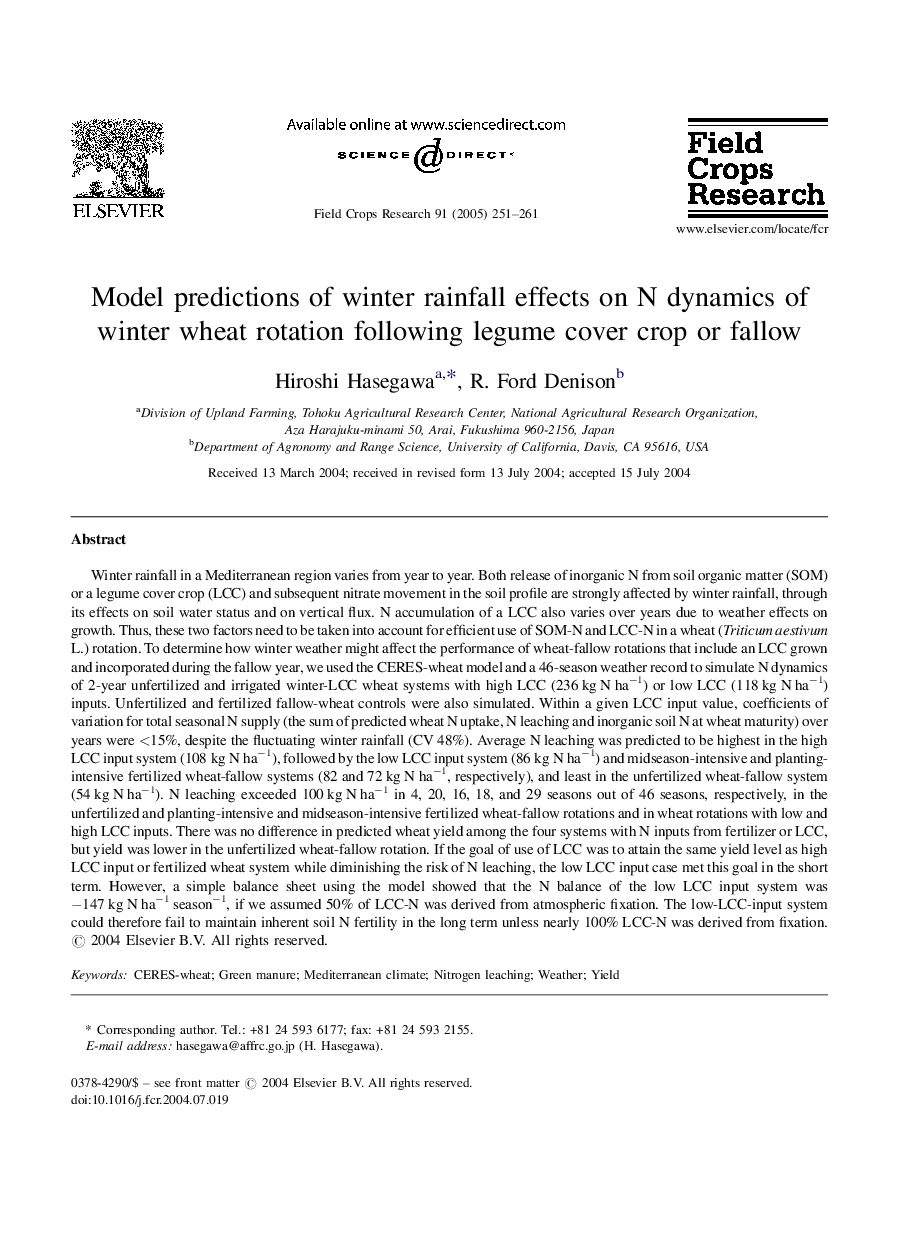| کد مقاله | کد نشریه | سال انتشار | مقاله انگلیسی | نسخه تمام متن |
|---|---|---|---|---|
| 9473575 | 1624758 | 2005 | 11 صفحه PDF | دانلود رایگان |
عنوان انگلیسی مقاله ISI
Model predictions of winter rainfall effects on N dynamics of winter wheat rotation following legume cover crop or fallow
دانلود مقاله + سفارش ترجمه
دانلود مقاله ISI انگلیسی
رایگان برای ایرانیان
کلمات کلیدی
موضوعات مرتبط
علوم زیستی و بیوفناوری
علوم کشاورزی و بیولوژیک
علوم زراعت و اصلاح نباتات
پیش نمایش صفحه اول مقاله

چکیده انگلیسی
Winter rainfall in a Mediterranean region varies from year to year. Both release of inorganic N from soil organic matter (SOM) or a legume cover crop (LCC) and subsequent nitrate movement in the soil profile are strongly affected by winter rainfall, through its effects on soil water status and on vertical flux. N accumulation of a LCC also varies over years due to weather effects on growth. Thus, these two factors need to be taken into account for efficient use of SOM-N and LCC-N in a wheat (Triticum aestivum L.) rotation. To determine how winter weather might affect the performance of wheat-fallow rotations that include an LCC grown and incorporated during the fallow year, we used the CERES-wheat model and a 46-season weather record to simulate N dynamics of 2-year unfertilized and irrigated winter-LCC wheat systems with high LCC (236 kg N haâ1) or low LCC (118 kg N haâ1) inputs. Unfertilized and fertilized fallow-wheat controls were also simulated. Within a given LCC input value, coefficients of variation for total seasonal N supply (the sum of predicted wheat N uptake, N leaching and inorganic soil N at wheat maturity) over years were <15%, despite the fluctuating winter rainfall (CV 48%). Average N leaching was predicted to be highest in the high LCC input system (108 kg N haâ1), followed by the low LCC input system (86 kg N haâ1) and midseason-intensive and planting-intensive fertilized wheat-fallow systems (82 and 72 kg N haâ1, respectively), and least in the unfertilized wheat-fallow system (54 kg N haâ1). N leaching exceeded 100 kg N haâ1 in 4, 20, 16, 18, and 29 seasons out of 46 seasons, respectively, in the unfertilized and planting-intensive and midseason-intensive fertilized wheat-fallow rotations and in wheat rotations with low and high LCC inputs. There was no difference in predicted wheat yield among the four systems with N inputs from fertilizer or LCC, but yield was lower in the unfertilized wheat-fallow rotation. If the goal of use of LCC was to attain the same yield level as high LCC input or fertilized wheat system while diminishing the risk of N leaching, the low LCC input case met this goal in the short term. However, a simple balance sheet using the model showed that the N balance of the low LCC input system was â147 kg N haâ1 seasonâ1, if we assumed 50% of LCC-N was derived from atmospheric fixation. The low-LCC-input system could therefore fail to maintain inherent soil N fertility in the long term unless nearly 100% LCC-N was derived from fixation.
ناشر
Database: Elsevier - ScienceDirect (ساینس دایرکت)
Journal: Field Crops Research - Volume 91, Issues 2â3, 14 February 2005, Pages 251-261
Journal: Field Crops Research - Volume 91, Issues 2â3, 14 February 2005, Pages 251-261
نویسندگان
Hiroshi Hasegawa, R. Ford Denison,